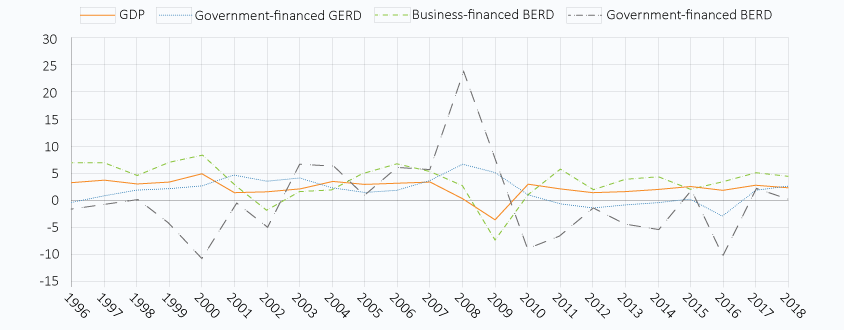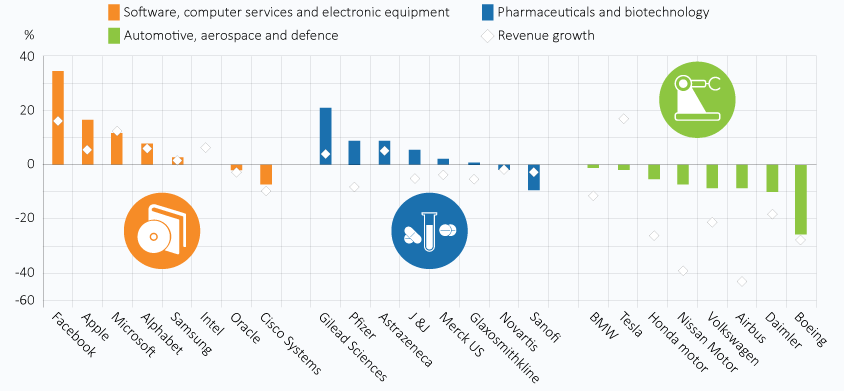Times of crisis and opportunity
Business research and innovation have been affected unevenly by the crisis
The COVID-19 crisis has disrupted the normal functioning of innovation systems. On an aggregate basis, business investments in research and innovation are pro-cyclical, and thus prone to contracting in times of crisis (see figure).
The impact of the business cycle on business R&D and government support
OECD area, annual growth rate

Source: OECD Main Science and Technology Indicators (database), http://oe.cd/msti (accessed October 2020). StatLink https://doi.org/10.1787/888934223460
This crisis may be different, however, since some of the companies that spend most on R&D appear to be expanding their R&D activities during the crisis. Some businesses, particularly in the digital and pharmaceutical sectors, have thrived during the pandemic, raising their R&D investments, while major companies in other sectors – including automotive, aerospace and defence – have reduced their R&D spending (see figure).
Reported R&D expense and revenue growth in selected R&D companies
Percentage change between April-September 2019 and April-September 2020

Source: OECD calculations, based on published quarterly business financial reports, December 2020. StatLink https://doi.org/10.1787/888934223156
The crisis has also accelerated the use of digital technologies to facilitate telework, e-learning, e-commerce and other activities. This has enabled parts of the economy and society to continue working, thereby mitigating the pandemic’s impact. The extent to which such applications permanently change behaviours is uncertain, but there are strong indications of a lasting shift that will drive and co-evolve with advances in digital innovation. However, the crisis could exacerbate existing gaps in the uptake and use of digital technologies – between large firms and small and medium sized enterprises (SMEs), in particular, but also between sectors. If not addressed, such uneven diffusion may have important implications for firms’ productivity performance as the pandemic continues to accelerate digitalisation. It could widen the productivity gap between digital adopters and digital laggards, deepen the vulnerability of laggards, and reduce economic resilience. Greater policy efforts will therefore be needed to boost the adoption and diffusion of digital tools, in particular for SMEs.
- Governments acted quickly to fund COVID-19-related research and innovation at scale
- The pandemic has triggered an unprecedented mobilisation of the scientific community
- Despite the disruption, scientists have continued their work during the crisis
- Responses to the crisis have drawn upon the innovative potential of businesses
- Business research and innovation have been impacted unevenly by the crisis
- Much of the research and innovation response to COVID-19 has been international
‹ Homepage
Related Documents
- Postgraduate training regimes need reforming to support a diversity of career paths
- Responses to the crisis have drawn upon the innovative potential of businesses
- The pandemic has triggered an unprecedented mobilisation of the scientific community
- Growing government debt could lead to austerity, and some hard choices for research and innovation policy
- Government R&D expenditures may need to shift to reflect new priorities
- Much of the research and innovation response to COVID-19 has been international
- Building government capabilities to meet future challenges will be a major challenge in itself
- Global challenges require global solutions
- Despite the disruption, scientists have continued their work during the crisis
- The STI policy mix needs to be more targeted
- Governments acted quickly to fund COVID-19-related research and innovation at scale